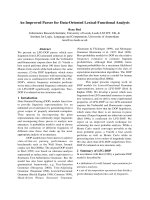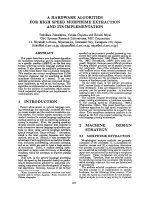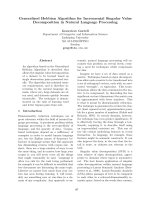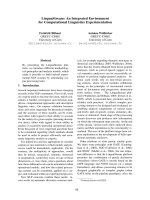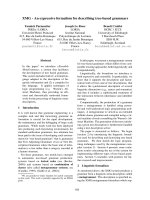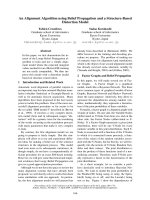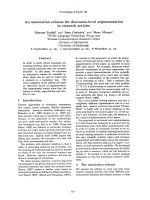Báo cáo toán học: " An Embedding Algorithm for Supercodes and Sucypercodes Kieu Van Hung and Nguyen Quy Khang Hanoi Pedagogical " doc
Bạn đang xem bản rút gọn của tài liệu. Xem và tải ngay bản đầy đủ của tài liệu tại đây (122.21 KB, 8 trang )
Vietnam Journal of Mathematics 33:2 (2005) 199–206
An Embedding Algorithm
for Supercodes and Sucypercodes
Kieu Van Hung and Nguyen Quy Khang
Hanoi Pedagogical University No. 2, Phuc Yen, Vinh Phuc, Vietnam
Received July 21, 2004
Revised October 15, 2004
Abstract. Supercodes and sucypercodes, particular cases of hypercodes, have been
introduced and considered by D. L. Van and the first author of this paper. In particular,
it has been proved that, for such classes of codes, the embedding problem has positive
solution. Our aim in this paper is to propose another embedding algorithm which, in
some sense, is simpler than those obtained earlier.
1. Preliminaries
Hypercodes, a special kind of prefix codes (suffix codes), are subject of many
research works (see [7, 8] and the papers cited there). They have some interesting
properties. In particular, every hypercode over a finite alphabet is finite (see [7]).
Supercodes and sucypercodes, particular cases of hypercodes, have been in-
troduced and considered in [2, 3, 9 -11]. In particular, supercodes were intro-
duced and studied in depth by D. L. Van [9].
For a given class C of codes, a natural question is whether every code X
satisfying some property p (usually, the finiteness or the regularity) is included
in a code Y maximal in C which still has the property p. This problem, which
we call the embedding pr oblem for the class C, attracts a lot of attention. Un-
fortunately, this problem was solved only for several cases by means of different
combinatorial techniques (see [10]).
The embedding problem for supercodes and sucypercodes was solved posi-
tively by applying the general embedding schema of Van [9, 10]. Moreover, an
effective embedding algorithm for supercodes over two-letter alphabets, was also
proposed [9].
200 Kieu Van Hung and Nguyen Quy Khang
In this paper we propose embedding algorithms for these kinds of codes other
than those obtained earlier. It is worthy to note that this method allows us to
obtain similar embedding algorithms for r
n
-supercodes and r
n
- sucypercodes.
We now recall some notions, notations and facts, which will be used in the
sequel. Let A be a finite alphabet and A
∗
the set of all the words over A.The
empty word is denoted by 1 and A
+
stands for A
∗
− 1. The number of all
occurrences of letters in a word u is the length of u, denoted by |u|.
A language over A is a subset of A
∗
. A language X is a code over A if for
all n, m ≥ 1andx
1
, ,x
n
,y
1
, ,y
m
∈ X, the condition
x
1
x
2
x
n
= y
1
y
2
y
m
,
implies n = m and x
i
= y
i
for i =1, ,n.AcodeX is maximal over A if X
is not properly contained in any other code over A.LetC be a class of codes
over A and X ∈ C. The code X is maximal in C (not necessarily maximal as a
code) if X is not properly contained in any other code in C. For further details
of the theory of codes we refer to [1, 5, 7].
An infix (i.e. factor)ofawordv is a word u such that v = xuy for some
x, y ∈ A
∗
; the infix is proper if xy = 1. A subset X of A
+
is an infix code if no
word in X is a proper infix of another word in X.
Let u, v ∈ A
∗
. We say that a word u is a subword of v if, for some n ≥ 1,u =
u
1
u
n
,v = x
0
u
1
x
1
u
n
x
n
with u
1
, ,u
n
,x
0
, ,x
n
∈ A
∗
.Ifx
0
x
n
=1
then u is called a proper subword of v. A subset X of A
+
is a hypercode if no
word in X is a proper subword of another word in it. The class C
h
of hypercodes
is evidently a subclass of the class C
i
of infix codes. For more details about infix
codes and hypercodes, see [4, 6 - 8].
Given u, v ∈ A
∗
.Thewordu is called a permutation of v if |u|
a
= |v|
a
for all
a ∈ A,where|u|
a
denotes the number of occurrences of a in u.Andu is a cyclic
permutation of v if there exist words x, y such that u = xy and v = yx.Weshall
denote by π(v)andσ(v) the sets of all permutations and cyclic permutations of
v, respectively.
Definition 1.1. AsubsetX of A
+
is a supercode (sucypercode) over A if no
word in X is a proper subword of a permutation (cyclic permutation, resp.)
of another word in it. Denote by C
sp
and C
scp
the classes of all superco des and
sucypercodes over A, respectively.
Thus, every supercode is a sucypercode and every sucypercode is a hyper-
code. Hence, all supercodes and sucypercodes are finite (see [10]).
Example 1.2.
(i) Every uniform code over A which is a subset of A
k
, k ≥ 1, is a supercode
and a sucypercode over A.
(ii) Consider the subset X = {ab, b
2
a} over A = {a, b}.Sinceab is not a proper
subword of b
2
a, X is a hypercode. But X is not a sucypercode, because ab is a
proper subword of ab
2
, a cyclic permutation of b
2
a.
(iii) The Y = {abab, a
2
b
3
} over A = {a, b} is a sucypercode, because abab is not
a proper subword of any word in σ(a
2
b
3
)={a
2
b
3
,ba
2
b
2
,b
2
a
2
b, b
3
a
2
,ab
3
a}.As
An Embedding Algorithm for Super codes and Sucypercodes 201
abab is a proper subword of the permutation abab
2
of a
2
b
3
,wehaveY is not a
supercode.
For any set X we denote by P(X) the family of all subsets of X. Recall that
a substitution is a mapping f from B into P(C
∗
), where B and C are alphabets.
If f(b)isregularforallb ∈ B then f is called a regular substitution.Whenf(b)
is a singleton for all b ∈ B it induces a homomorphism from B
∗
into C
∗
.Let#
be a new letter not being in A.PutA
#
= A ∪{#}. Let us consider the regular
substitutions S
1
,S
2
and the homomorphism h defined as follows
S
1
: A →P(A
∗
#
), where S
1
(a)={a, #} for all a ∈ A;
S
2
: A
#
→P(A
∗
), with S
2
(#) = A
+
and S
2
(a)={a} for all a ∈ A;
h : A
∗
#
→ A
∗
, with h(#) = 1 and h(a)=a for all a ∈ A.
Actually, the substitution S
1
is used to mark the occurrences of letters to be
deleted from a word. The homomorphism h realizes the deletion by replacing
# by empty word. The inverse homomorphism h
−1
“chooses” in a word the
positions where the words of A
+
inserted, while S
2
realizes the insertions by
replacing # by A
+
.
Denote by A
[n]
the set of all the words in A
∗
whose length is less than or
equal to n. For every subset X of A
∗
,wedenoteXA
−
= X(A
+
)
−1
= {w ∈
A
∗
| wy ∈ X, y ∈ A
+
}, A
−
X =(A
+
)
−1
X = {w ∈ A
∗
| yw ∈ X,y ∈ A
+
} and
A
−
XA
−
=(A
+
)
−1
X(A
+
)
−1
. The following result has been proved in [10] (see
also [2]).
Theorem 1.3. The embedding problem has positive answer in the finite case
for every class C
α
of c odes, α ∈{i, h, scp, sp}. More precisely, every finite code
X in C
α
,withmax X = n, is included in a code Y which is maximal in C
α
and remains finite with max Y =maxX.Namely,Y can be computed by the
following formulas according to the case.
(i) For infix codes
Y = Z − (ZA
+
∪ A
+
Z ∪ A
+
ZA
+
) ∩ A
[n]
,
where Z = A
[n]
− F − (XA
+
∪ A
+
X ∪ A
+
XA
+
) ∩ A
[n]
and F = XA
−
∪
A
−
X ∪ A
−
XA
−
.
(ii) For hypercodes
Y = Z − S
2
(h
−1
(Z) ∩ (A
∗
#
{#}A
∗
#
) ∩ A
[n]
#
) ∩ A
[n]
,
where Z = A
[n]
− h(S
1
(X) ∩ (A
∗
#
{#}A
∗
#
)) − S
2
(h
−1
(X) ∩ (A
∗
#
{#}A
∗
#
) ∩
A
[n]
#
) ∩ A
[n]
.
(iii) For sucypercodes
Y = Z − σ(S
2
(h
−1
(Z) ∩ (A
∗
#
{#}A
∗
#
) ∩ A
[n]
#
) ∩ A
[n]
),
where Z = A
[n]
−h(S
1
(σ(X))∩(A
∗
#
{#}A
∗
#
))−σ(S
2
(h
−1
(X)∩(A
∗
#
{#}A
∗
#
)∩
A
[n]
#
) ∩ A
[n]
).
202 Kieu Van Hung and Nguyen Quy Khang
(iv) For supercodes
Y = Z − π(S
2
(h
−1
(Z) ∩ (A
∗
#
{#}A
∗
#
) ∩ A
[n]
#
) ∩ A
[n]
),
where Z = A
[n]
− h(S
1
(π(X)) ∩ (A
∗
#
{#}A
∗
#
)) − π(S
2
(h
−1
(X) ∩ (A
∗
#
{#}A
∗
#
) ∩
A
[n]
#
) ∩ A
[n]
).
2. Embedding Algorithms
We propose in this section embedding algorithms for supercodes and sucyper-
codes. These algorithms use only the permutation π or the cyclic permutation
σ at the last step. Particularly, an effective algorithm for supercodes over two-
letter alphabets is established.
Let A be a finite, totally ordered alphabet, and let ∼ be an equivalence
relation on A
∗
. For every [w]ofA
∗
/ ∼,wedenotebyw
0
the lexicographically
minimal word of [w]. On A
∗
, we introduce two equivalence relations ∼
π
and ∼
σ
defined by
u ∼
π
v ⇔∀a ∈ A : |u|
a
= |v|
a
,
u ∼
σ
v ⇔∃x, y ∈ A
∗
: u = xy, v = yx.
We denote by A
∗
π
= {w
0
∈ [w] | [w] ∈ A
∗
/ ∼
π
} and A
∗
σ
= {w
0
∈ [w] | [w] ∈
A
∗
/ ∼
σ
}.
Let ρ ∈{π,σ}. A subset X of A
∗
ρ
is called an infix code (a hypercode) on A
∗
ρ
if it is an infix code (resp., a hypercode) over A.DenotebyC
i|A
∗
ρ
and C
h|A
∗
ρ
the
sets of all infix codes and hypercodes on A
∗
ρ
, respectively.
Lemma 2.1. If |A| =2then C
h|A
∗
π
= C
i|A
∗
π
.
Proof. Since C
h|A
∗
π
⊆ C
i|A
∗
π
is trivial, it suffices to show that C
i|A
∗
π
⊆ C
h|A
∗
π
.
Suppose the contrary that there exists X ∈ C
i|A
∗
π
but X/∈ C
h|A
∗
π
.LetA =
{a, b}. Then, for all w in A
∗
π
, w has the form w = a
m
b
n
with m, n ≥ 0. Since
X/∈ C
h|A
∗
π
, it follows that there exist u, v ∈ X such that u ≺
h
v. Therefore,
u = a
m
b
n
, v = a
k
b
with 0 ≤ m ≤ k,0≤ n ≤ and m + n<k+ . Hence
u ≺
i
v, which contradicts X ∈ C
i|A
∗
π
.Thus,C
i|A
∗
π
⊆ C
h|A
∗
π
.
From the fact that every hypercode is finite and from Lemma 2.1, it follows
that all the infix codes on A
∗
π
with |A| = 2, are finite.
We now consider two maps λ
π
: A
∗
→ A
∗
π
, λ
π
(w)=w
0
and λ
σ
: A
∗
→ A
∗
σ
,
λ
σ
(w)=w
0
. The following result establishes relationship between supercodes
and sucypercodes with the images of them with respect to the maps λ
π
and λ
σ
.
Theorem 2.2. For any X ⊆ A
+
, we have the following assertions
(i) X ∈ C
sp
⇔ λ
π
(X) ∈ C
h|A
∗
π
.Particularly,if|A| =2then X ∈ C
sp
⇔
λ
π
(X) ∈ C
i|A
∗
π
.
(ii) X ∈ C
scp
⇔ λ
σ
(X) ∈ C
h|A
∗
σ
.
An Embedding Algorithm for Super codes and Sucypercodes 203
Proof. We treat only the item (i). For the item (ii) the argument is similar. Let
X ∈ C
sp
but λ
π
(X) /∈ C
h|A
∗
π
. Then, there exist u
0
,v
0
∈ λ
π
(X) such that u
0
≺
h
v
0
.Sinceu
0
,v
0
∈ λ
π
(X), there are u, v ∈ X satisfying u ∈ π(u
0
),v ∈ π(v
0
).
Hence, from u
0
≺
h
v
0
it follows that u ≺
sp
v, which contradicts the fact that
X ∈ C
sp
.Thus,λ
π
(X) ∈ C
h|A
∗
π
. Conversely, suppose that λ
π
(X) ∈ C
h|A
∗
π
.If
X/∈ C
sp
, i.e. ∃u, v ∈ X: u ≺
sp
v,thenλ
π
(u) ≺
h
λ
π
(v), a contradiction. So,
X ∈ C
sp
.
If |A| = 2 then, by Lemma 2.1, C
h|A
∗
π
= C
i|A
∗
π
. Therefore, by the above,
X ∈ C
sp
⇔ λ
π
(X) ∈ C
h|A
∗
π
⇔ λ
π
(X) ∈ C
i|A
∗
π
.
An infix code (a hypercode) X on A
∗
π
(resp., A
∗
σ
)ismaximal on A
∗
π
(resp.,
A
∗
σ
) if it is not properly contained in any one on A
∗
π
(resp., A
∗
σ
). The following
assertion establishes relationship between maximal hypercodes on A
∗
π
(resp., A
∗
σ
)
and maximal supercodes (resp., sucypercodes) over A.
Theorem 2.3. For any X ⊆ A
+
, we have the following
(i) If X is a maximal hypercode on A
∗
π
then π(X) is a maximal supercod e over
A.Inparticular,if|A| =2and X is a maximal infix code on A
∗
π
then
π(X) is a maximal sup ercode over A.
(ii) If X is a maximal hyp ercode on A
∗
σ
then σ(X) is a maximal sucypercode
over A.
Proof. We prove only the item (i). For the remaining item the argument is sim-
ilar. Let X be a maximal hypercode on A
∗
π
. By definition, π(X)isasupercode
over A.Ifπ(X) is not a maximal supercode over A then there exist u, v ∈ π(X)
such that u ≺
sp
v.Thenλ
π
(u),λ
π
(v) ∈ X and λ
π
(u) ≺
h
λ
π
(v), a contradiction.
Thus, π(X) must be a maximal supercode over A.
For the case |A| = 2, the assertion follows immediately from the above and
Lemma 2.1.
Denote by A
[n]
ρ
, ρ ∈{π,σ}, the set of all the words in A
∗
ρ
whose length is less
than or equal to n. For every X of A
∗
π
,wedenoteXA
−
π
= X(A
+
π
)
−1
, A
−
π
X =
(A
+
π
)
−1
X and A
−
π
XA
−
π
=(A
+
π
)
−1
X(A
+
π
)
−1
. As a consequence of Theorem 1.3
we have
Theorem 2.4. The following assertions are true
(i) Let A = { a, b} and let X ∈ C
i|A
∗
π
with max X = n.Then,thereexistsa
maximal infix code Y on A
∗
π
with max X =maxY which can be computed
by the formulas
Y = Z − (Zb
+
∪ a
+
Z ∪ a
+
Zb
+
) ∩ A
[n]
π
,
where Z = A
[n]
π
− F − (Xb
+
∪a
+
X ∪a
+
Xb
+
)∩A
[n]
π
and F = XA
−
π
∪A
−
π
X ∪
A
−
π
XA
−
π
.
(ii) Let ρ ∈{π, σ} and let X ∈ C
h|A
∗
ρ
with max X = n.Then,thereexistsa
maximal hypercode Y on A
∗
ρ
with max X =maxY which can be computed
by the formulas
204 Kieu Van Hung and Nguyen Quy Khang
Y = Z − S
2
(h
−1
(Z) ∩ (A
∗
#
{#}A
∗
#
) ∩ A
[n]
#
) ∩ A
[n]
ρ
,
where Z = A
[n]
ρ
−h(S
1
(X)∩(A
∗
#
{#}A
∗
#
))∩A
[n]
ρ
−S
2
(h
−1
(X)∩(A
∗
#
{#}A
∗
#
)∩
A
[n]
#
) ∩ A
[n]
ρ
.
Proof. It follows immediately from Theorem 1.3(i) and (ii) with the notice that
A
∗
π
= a
∗
b
∗
,whereA = {a, b}.
By virtue of Theorems 2.2, 2.3 and 2.4, embedding algorithms for supercodes
and sucypercodes can be presented as follows.
Algorithm SP
Input: A supercode X over A with max X = n.
Output: A maximal supercode Y over A containing X,withmaxY = n.
1. Finding X
= λ
π
(X). By Theorem 2.2(i), X
is a hypercode on A
∗
π
.In
particular, X
is an infix code on A
∗
π
,if|A| =2.
2. We compute a maximal infix code (hypercode) Y
on A
∗
π
which contains
X
by the formulas in Theorem 2.4(i) or (ii). Then, by Theorem 2.3(i),
Y = π(Y
) is a maximal supercode over A.ThesetY contains X because
X ⊆ π(X
) ⊆ π(Y
)=Y .
Algorithm SCP
Input: A sucypercode X over A with max X = n.
Output: A maximal sucypercode Y over A containing X,withmaxY = n.
1. Finding X
= λ
σ
(X). By Theorem 2.2(ii), X
is a hypercode on A
∗
σ
.
2. We compute a maximal hypercode Y
on A
∗
σ
which contains X
by the
formulas in Theorem 2.4(ii). Then, by Theorem 2.3(ii), Y = σ(Y
)is
a maximal sucypercode over A.ThesetY contains X because X ⊆
σ(X
) ⊆ σ(Y
)=Y .
3. Examples
In this section, we consider some examples by applying the above embedding
algorithms.
Example 3.1. Consider the supercode X = {a
2
b
2
ab
2
,a
3
ba
2
b, b
4
ab
3
} over the
alphabet A = {a, b} with max X = 8. By Algorithm SP, we may compute a
maximal supercode Y over A which contains X as follows
1. We have X
= λ
π
(X)={a
3
b
4
,a
5
b
2
,ab
7
} is an infix code on A
∗
π
= a
∗
b
∗
.
2. Since max X
= 8, we can compute a maximal infix code Y
on A
∗
π
which
contains X
by the formulas in Theorem 2.4(i) with n = 8. We shall do it now
step by step.
X
A
−
π
= {1,a,a
2
,ab,a
3
,ab
2
,a
4
,a
3
b, ab
3
,a
5
,a
3
b
2
,ab
4
,a
5
b, ba
5
,a
3
b
3
,ab
6
};
An Embedding Algorithm for Super codes and Sucypercodes 205
A
−
π
X
= {1,b,b
2
,ab
2
,b
3
,a
2
b
2
,b
4
,a
3
b
2
,ab
4
,b
5
,a
4
b
2
,a
2
b
4
,b
6
,b
7
};
A
−
π
X
A
−
π
= {1,a,b,a
2
,ab,b
2
,a
3
,a
2
b, ab
2
,b
3
,a
4
,a
3
b, a
2
b
2
,ab
3
,b
4
,
a
4
b, a
2
b
3
,b
5
,b
6
};
F = X
A
−
π
∪ A
−
π
X
∪ A
−
π
X
A
−
π
= {1,a,b,a
2
,ab,b
2
,a
3
,a
2
b, ab
2
,b
3
,a
4
,a
3
b,
a
2
b
2
,ab
3
,b
4
,a
5
,a
4
b, a
3
b
2
,a
2
b
3
,ab
4
,b
5
,a
5
b, a
4
b
2
,a
3
b
3
,a
2
b
4
,ba
5
,b
6
,ab
6
,b
7
};
(X
b
+
∪ a
+
X
∪ a
+
X
b
+
) ∩ A
[8]
π
= {a
6
b
2
,a
5
b
3
,a
4
b
4
,a
3
b
5
};
Z = A
[8]
π
− F −{a
6
b
2
,a
5
b
3
,a
4
b
4
,a
3
b
5
} = { a
6
,a
7
,a
6
b, a
5
b
2
,a
4
b
3
,a
3
b
4
,a
2
b
5
,
a
8
,a
7
b, a
2
b
6
,ab
7
,b
8
};
(Zb
+
∪ a
+
Z ∪ a
+
Zb
+
) ∩ A
[8]
π
= {a
7
,a
6
b, a
8
,a
7
b, a
6
b
2
,a
5
b
3
,a
4
b
4
,a
3
b
5
,a
2
b
6
};
Y
= {a
6
,a
5
b
2
,a
4
b
3
,a
3
b
4
,a
2
b
5
,ab
7
,b
8
}.
So, Y = π({a
6
,a
5
b
2
,a
4
b
3
,a
3
b
4
,a
2
b
6
,ab
7
,b
8
}) is a maximal supercode over A
containing X.
Example 3.2. Let us consider the language X = {acb, a
2
b
2
,cabc} over the alpha-
bet A = {a, b, c}. It is not difficult to check that this language is a sucypercode,
not being a supercode. By Algorithm SCP, we can compute a maximal sucyper-
code Y over A containing X as follows
1. We have X
= λ
σ
(X)={acb, a
2
b
2
,abc
2
} which is a hypercode on A
∗
σ
.
2. Since max X
= 4, we may compute a maximal hypercode Y
on A
∗
σ
which
contains X
by the formulas in Theorem 2.4(ii) as follows
S
1
(X
) ∩ (A
∗
#
{#}A
∗
#
)={#cb, a#b, ac#, #
2
b, #c#,a#
2
, #
3
, #ab
2
,a#b
2
,
a
2
#b, a
2
b#, #
2
b
2
, #a#b, a#
2
b, #ab#,a#b#,a
2
#
2
, #
3
b, #
2
b#, #a#
2
,
a#
3
, #
4
, #bc
2
,a#c
2
,ab#c, abc#, #
2
c
2
, #b#c, a#
2
c, #bc#,a#c#,ab#
2
,
#
3
c, #
2
c#, #b#
2
};
h(S
1
(X
) ∩ (A
∗
#
{#}A
∗
#
)) ∩ A
[4]
σ
= {1,a,b,c,a
2
,ab,ac,b
2
,bc,c
2
,a
2
b, ab
2
,
abc, ac
2
,bc
2
};
h
−1
(X
) ∩ (A
∗
#
{#}A
∗
#
) ∩ A
[4]
#
= {#acb, acb#,ac#b, a#cb};
S
2
(h
−1
(X
) ∩ (A
∗
#
{#}A
∗
#
) ∩ A
[4]
#
) ∩ A
[4]
σ
= {a
2
cb, acb
2
, acbc, ac
2
b, abcb};
Z = {a
3
,a
2
c, acb, b
3
,b
2
c, c
3
,a
4
,a
3
b, a
3
c, a
2
b
2
,a
2
bc, a
2
c
2
, abab, abac, ab
3
,
ab
2
c, abc
2
, acac, ac
3
,b
4
,b
3
c, b
2
c
2
, bcbc, bc
3
,c
4
};
h
−1
(Z) ∩ (A
∗
#
{#}A
∗
#
) ∩ A
[4]
#
= {#a
3
,a
3
#,a
2
#a, a#a
2
, #a
2
c, a
2
c#,
a
2
#c, a#ac, #acb, acb#,ac#b, a#cb, #b
3
,b
3
#,b
2
#b, b#b
2
, #b
2
c,
b
2
c#,b
2
#c, b#bc, #c
3
,c
3
#,c
2
#c, c#c
2
};
S
2
(h
−1
(Z) ∩ (A
∗
#
{#}A
∗
#
) ∩ A
[4]
#
) ∩ A
[4]
σ
= {a
4
,a
3
b, a
3
c, a
2
cb, a
2
c
2
,a
2
bc,
abac, acac, acb
2
, acbc, ac
2
b, abcb, ab
3
,b
4
,b
3
c, ab
2
c, b
2
c
2
, bcbc, ac
3
,bc
3
,c
4
};
Y
= {a
3
,a
2
c, acb, b
3
,b
2
c, c
3
,a
2
b
2
, abab, abc
2
}.
Thus, Y = σ({a
3
,a
2
c, acb, b
3
,b
2
c, c
3
,a
2
b
2
, abab, abc
2
}) is a maximal sucyper-
code over A which contains X.
206 Kieu Van Hung and Nguyen Quy Khang
Acknowledgement. The authors would like to thank his colleagues in the seminar
Mathematical Foundation of Computer Science at Hanoi Institute of Mathematics for
their useful discussions and attention to the work. Especially, the authors are indebted
to Profs. Do Long Van and Phan Trung Huy for their kind help.
References
1. J. Berstel and D. Perrin, Theory of Codes, Academic Press, New York, 1985.
2. K. V. Hung, P. T. Huy, and D. L. Van, On some classes of codes defined by binary
relations, Acta Math. Vietnam. 29 (2) (2004) 163–176.
3. K. V. Hung, P. T. Huy, and D. L. Van, Codes concerning roots of words, Vietnam
J. Math. 32 (2004) 345–359.
4. M. Ito, H. J¨urgensen, H. Shyr, and G. Thierrin, Outfix and infix co des and related
classes o f languages, J. Computer and System Sciences 43 (1991) 484–508.
5. H. J¨urgensen and S. Konstatinidis, Codes, G. Rozenberg and A. Salomaa (Eds.),
Handbook of Formal Languages, Springer, Berlin, 1997, 511–607.
6. N. H. Lam, Finite maximal infix codes, Semigroup Forum 61 (2000) 346–356.
7. H. Shyr, Free Monoids and Languages, Hon Min Book Company, Taichung, 1991.
8. H. Shyr and G. Thierrin, Hyp erco d es, Information and Control 24 (1974) 45–54.
9. D. L. Van, On a class of hypercodes, in M. Ito, T. Imaoka (Eds.), Words, Languages
and Combinatorics III (Proceedings of the 3rd International Colloquium, Kyoto,
2000), World Scientific, 2003, 171-183.
10. D. L. Van and K. V. Hung, An approach to the embedding problem for codes
defined by binary relations, J. Automata, Languages and Combinatorics, 2004,
submitted (21 pages).
11. D. L. Van and K. V. Hung, Characterizations of some classes of codes defined by
binary relations, J. Automata, Languages and Combinatorics, 2004, submitted (16
pages).



